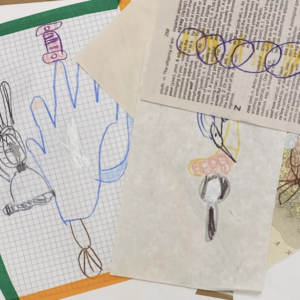Pathway: Exploring the World Through Mono Print
Pathway for Years 1 & 2
Disciplines:
Printmaking (Mono Print), Drawing, Collage
Key Concepts:
-
When we make mono prints we use mark making to create one off prints.
-
When we make mono prints we create an impression of a drawing.
-
That we can generate playful narratives and inventions through drawing.
-
That we understand that using a range of marks will generate different effects when creating mono prints.
-
That we can create creative responses to different stimuli and make the work our own.
Building on the exploration of drawing in Autumn term 1, this pathway starts with two explorations of drawing – one drawing from photographs or film, and two drawing from small, closely observed objects.
In both sessions pupils develop drawing and mark making skills.
Children are then introduced to mono print. They explore the work of an artist who uses mono print in his own work, and are introduced to a simple mono print technique.
Classes then have a choice of projects to develop mono printing and drawing skills, depending upon their preferred area of subject focus.
This pathways encourages children to take creative risks and use drawing as a way to playfully invent and create narratives.
Themes: Natural and Manmade Forms, Invention, Narrative
Medium: Graphite pencils, Oil Pastels, Carbon Paper
Artists: Xgaoc’o X’are, Leonardo Di Vinci
This pathway will take approximately half a term, based upon a weekly art lesson.
If you use this resource in your setting, please tag us on social media: #InspiredBy @accessart (facebook, twitter) @accessart.org.uk (instagram) and share the url. Thank you!




Teaching Notes
Find the MTP for this pathway here.
See the recording of the hour long zoom CPD to introduce teachers to this pathway.
Curriculum Links
English: Link to English by asking children to draw upon their own experience for narratives.
Geography: Adapt to explore habitats, continents.
Maths: Use language to develop understanding of symmetry (peeling back monoprints).
Science: Animals, trees, materials.
PSHE: Peer discussion. Collaboration.
Be aware that you leave the making open enough for the children to explore fully and freely (not constrained by working too closely to a theme).
I Can…
-
I can make drawings using photos from films as my source material.
-
I can look closely guided by my teachers voice, and work in my sketchbook or on paper to make drawings using soft pencil or handwriting pen.
-
I can look closely at small objects close to me and make drawings with soft pencil or handwriting pen at the same scale or size.
-
I can think carefully about which marks I will include in my drawing.
-
I can share my sketchbook work with the class and talk about what I like about my work. I can listen to others talking about their work, and sometimes I can add my thoughts.
-
I have seen what a mono print is and have explored the work of an artist who uses mono print. I can share my thoughts on the artists work.
-
I can use carbon paper to make mono prints. I can experiment with the kinds of marks I make, and think about how they help make my drawings interesting.
-
I can base my drawings upon careful observational looking. I can slow down my looking and mark making and work for 5 to 15 minutes on a drawing.
-
I can explore a theme and make mono prints using my imagination to make my drawings personal.
-
I can share my work and talk about what I like, and what I would like to try again.
-
I can enjoy looking at the work of my classmates and sometimes I can share my thoughts about their work.
-
I have understood that through art, I can invent and discover.
Time
This pathway takes 6 weeks, with an hour per week. Shorten or lengthen the suggested pathway according to time and experience. Follow the stages in green for a shorter pathway or less complex journey.
Materials
Soft pencils, oil pastels/wax crayons, handwriting pens, carbon paper, A3 cartridge paper, tracing paper.
See the Pathway Used in Schools...


















